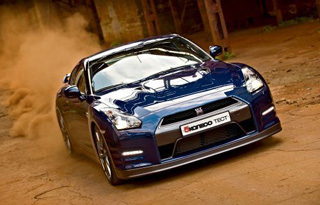Test drive Nissan GT-R R35 Restyling since 2011 compartment
Nissan GT-R test drive in the SPECV configuration. Godzilla on steroids
Tested equipment:Nissan GT-R 2009 compartment
What I liked:
Carbon-ceramic brakes; Suspension configured under the track; Special Bridgestone Potenza Re070R tires.
That I didn't like it:
Too heavy; very expensive.
Brief line:
Phenomenal handling, but is it worth the money?
Specification:
twin-Turbo, 3.8 l, V6
485 hp.; 607.4 nm
carbon-ceramic brakes
1 680 kg
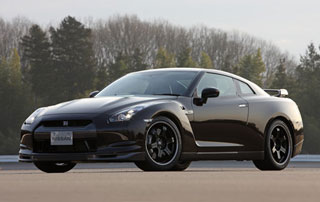 Nissan GT-R SPECV violates laws.
Nissan GT-R SPECV violates laws. Actually, GT-R began to do this last year. Indeed, until that moment, all Japanese automakers limited their sports cars 280 horsepower: unwritten, but zealously observed restriction introduced by the government of the country in 1989.
Nissan GT-R smashed this glass ceiling with its V6 with two turbines with a capacity of 480 hp. Nissan GT-R SPECV went along this path even further, strengthening the GT-R status as a real supercar. Just a year after the presentation of the Nissan model, GT-R made a steroid injection, creating the most extreme car for public roads from all those who have ever traveled to Japan.
And we intend to confirm this with the results of our test.
Extreme publication
Since the first spy images of the Nissan GT-R SPECV prototype made during running tests on the Nurgurgring ring last year, different ones spoke differently about this charged version of the Twin-Twin-Twin-Twin Cardy GT-R. We heard about the light carbon details of the body, raised by boost pressure, carbon-ceramic brakes, unique suspension settings and special tires. Now we were invited to the Nissan test track to Totigi, about two hours from Tokyo to try out SPECV. Well, we, in turn, took with us our equipment to record some data.
Cazetosi Mizutosi himself (chief engineer of the GT-R model) took us directly to the track, simultaneously painting the SPECV modification in the colors. We had a slight feeling that we were Mel Gibson in crazy Max, and the goose leads us to the underground workshop to show the crazy 600-horsepower special car to persecute criminals. The goose says: this car is what you need. She is a plague!
Perhaps Midzuno is not so eloquent, but no less inspired. He is the only chief engineer of all whom we know who reports immediately before the head of the concern, and after listening to his philosophy of Supercar, we understood why.
For example, Midzuno says: we think not like most engineers; We look the other way. When developing our GT-R, we initially installed the weight threshold, which should not exceed 1,750 kg, and only then we began to think about how to achieve this.
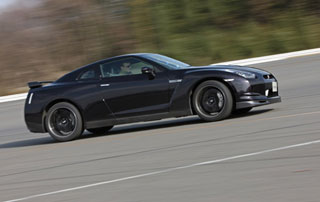 Time to lose weight
Time to lose weight Here, on the Totigi track, the Nissan GT-R SPECV looks more menacing than the standard GT-R. It is painted in the optional color of the Ultimate Black Opal (shade of dark purple) for $ 5,900, and the lattice, anterior brake ducts and the rear anti-wing from light carbonate. 20-inch aluminum forged disks Rays Engineering also contribute to weight loss. For an even greater reduction in mass, Mizuno decided to replace the rear seats with plastic covers. Recaro front buckets are made of thin carbon sheets for the sake of a diet.
As a result of these innovations, GT-R lost almost 60 kg, exposing the 1,680 as a result. Although, to be honest, we hoped that it would be possible to lose about 100 kg of weight.
The time has come for the next comments of Mizuno. GT-R is a supercar for everyone anywhere at any time. This car is created for those drivers who really enjoy fast driving and love to squeeze out the maximum of its capabilities from the car. That is why we sought to make the best brakes in the world for GT-R.
VDC or Launch Control?
Having received permission from Mizuno, we click the engine start button, and Specv wakes up with a deeper guttural sound than the standard GT-R thanks to the titanium release system, which we saw earlier at the NISMO GT-R configuration. A 3.8 liter of this SPECV is black is black, instead of silver, more than silver, moreover, 5 horses are more than in the stock GT-R before renewal. That is, in the end, SPECV turned out to be 485 hp. This is somewhat smaller than those 500 hp that we hoped for, but Midzuno has an explanation: we did not strive for this. We wanted to make the car more interesting in management, and not just add horses.
Part of the program to create a more pierced, if no more powerful, engine was the opportunity to raise the pressure pressure in those moments when the transmission in long gears, thereby increasing the torque to 607.4 nm in the interval between 3,500 and 5,000 revolutions per minute ( The increase in the peak moment is 19 nm).
When we were practically ready to start the acceleration test, Mizuno decided to remind us of a reconfigured VDC course control system for this system, all GT-R are equipped with this system, including SPECV equipment. He strongly recommended that we do not turn off this system, since the processed software of the engine control unit (as we suspect, increasing the pressure of turbines in the range of average revolutions from the same series) provides a car with the VDC on the same speed that he used to develop without this system.
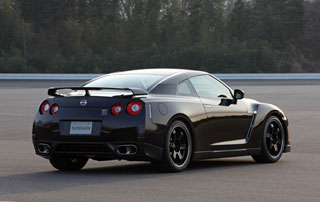 We smiled: so do you want us to turn on Launch Control (starting control system)?
We smiled: so do you want us to turn on Launch Control (starting control system)? What did you get no less smiling answer: what are you talking about? GT-R does not have such a function. Mizuno simply supported the official policy of the Nissan management, because in accordance with Japanese legislation, cars allowed for operation on public roads cannot be equipped with similar start control systems.
The speed of reactions
Since we left the VDC system turned on, it was not much sense to abruptly break off, unwinding the engine to 4,500 revolutions and smoke with tires. This is too much stress for the transmission, Midzuno reminded us. We followed his advice and, smoothly removing the right leg from the brake pedal, pressed the gas.
Nissan GT-R SPECV instantly reacts to our actions and breaks down, almost without slipping. It reaches 60 miles per hour (96 km/h) in 3.5 seconds, and a quarter of a mile flies in 11.4 s, accelerating at the finish of up to 200 km/h. For comparison, in a recent repeated test, our stock gt-r gains 60 miles/h for 3.6 s, and the quota conquers in 11.7 seconds at a speed of 190.7 km/h, which is quite comparable to the renewed brainchild of the concern when VDC turned on. .
Impressive. The conditions of this test are not similar to those under which we conducted testing in the United States (not only because this time another pilot), but if we take into account the influence of weather conditions on the performance of the experimental, then it goes on a par with the Chevrolet Corvette ZR1. ZR1 with a supercharger (with a capacity of 638 hp) accelerates from a place to 96 km/h for 3.8 s and overcomes 402 m in 11.5 seconds, accelerating at the finish to 206.5 km/h.
We collapse the cones
But it seems to us that on the slalom-test GT-R SPECV will make an even stronger impression. Its new suspension was configured by Nissan engineers for the fastest movement along the streets and tracks, Bilstein shock absorbers are not adjusted in stiffness.
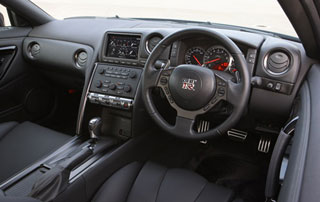 Its tires look almost like ordinary 20-inch Bridgestone Potenza Re070, but in fact it is not. To withstand extreme brakes that SPECV is capable of with its carbon-keramic brake discs and calipers of Brembo (6-piston in front and 4-piston in the back), Mizuno asked Bridgestone to add stiffness of tire sidewalls and make a treadmill that provides a large area of \u200b\u200bcontact of the rubber with the coating (What reminds us of Dunlop Sp Sport tires, incoming a standard GT-R).
Its tires look almost like ordinary 20-inch Bridgestone Potenza Re070, but in fact it is not. To withstand extreme brakes that SPECV is capable of with its carbon-keramic brake discs and calipers of Brembo (6-piston in front and 4-piston in the back), Mizuno asked Bridgestone to add stiffness of tire sidewalls and make a treadmill that provides a large area of \u200b\u200bcontact of the rubber with the coating (What reminds us of Dunlop Sp Sport tires, incoming a standard GT-R). There are really a lot of clutch with the road. In the test for lateral acceleration on the Totiga track, we managed to get 1.12G tremendous progress against the background of 0.93G GT-R on standard tires. This result is better than the achievements of ZR1 1.06G.
Having overcome on the all-wheel drive GT-R Shy, we immediately noted that at speed it became more collected. We did not feel insufficient rotation, the steering wheel is more lively and more responsive than ever before. We were not able to conduct this test in accordance with the protocol adopted in the United States, but with new equipment we managed to disperse GT-R to 120 km/h, which is almost 1.6 km/h faster than the standard copy of Bridgestone Potenza tires RE070. And here GT-R goes on a par with Corvette.
If we talk about a complete stop from 96 km/h, we were not able to improve the result of 32.31 meters. Perhaps we did not intensively sting the brake pedal enough, but the braking efficiency is more dependent on the tires, and in the lower composition of the brake discs. Or maybe the problem is in road dust. Who knows?
Finally, we went
And then, finally, the long -awaited Midzuno moment indicates in the direction of the wriggling track located in the rear of the test site. We pass the first round of the 4-km track of Nissan using approximately 80% of the GT-R SPECV potential, just to warm up the brakes a little. On the next circle, we open the throttle more, and click on the brakes later, getting deeper and deeper into each subsequent turn. SPECV, on the other hand, becomes only better and more interesting from this, gambling fond of us further along the track.
Nothing can prepare you for completely unrealistic braking power of carbon-ceramic discs used in full when slowing down from high speeds. We were told that with a sharp slowdown from 240 km/h, an effort develops up to 2G. And this is really so your body is uncontrollably pulling forward when you press the brake pedal into the floor. The sensations are almost the same as in the GT racing car. But GT-R remains collected even with such an extreme slowdown, passing you a frightening sense of calm even with an inexorable approach to a sharp turn. The sensations are as if you are about to leave the kinematic hyperspace, observing how the blurry landscape slows down and becomes more clear and distinguishable. The only disadvantage is the price of replacing worn disks and pads: it would be better for you to have an extra $ 50,000 in your pocket by that time.
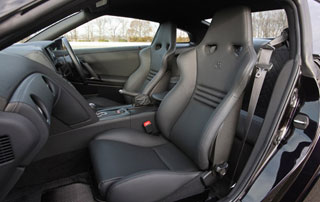 Leaving the next turn of the Nissan test track to Totigi, we switched our attention to the steering wheel responsible for increasing the pressure pressure in high gears to find out what the chip is. The inclusion of this function provides an additional 19 nm in the range between 3,500 and 5,000 revolutions for 80 seconds. This is enough to overcome half the track, for example, Fuji International Speedway, Mizuno explained to us.
Leaving the next turn of the Nissan test track to Totigi, we switched our attention to the steering wheel responsible for increasing the pressure pressure in high gears to find out what the chip is. The inclusion of this function provides an additional 19 nm in the range between 3,500 and 5,000 revolutions for 80 seconds. This is enough to overcome half the track, for example, Fuji International Speedway, Mizuno explained to us. Twice as expensive?
Nissan GT-R SPECV is a GT-R car created by Mizuno for a track, which combines brilliant brakes, super-chain rubber and suspension, which is in such a way that it behaves perfectly on the track and on ordinary roads. But all this costs a lot of money $ 161 800. It is twice as long as the standard GT-R, and $ 50,000 more expensive than Corvette ZR1. With such a high cost, GT-R is unlikely to have good sales in Japan, even if Nissan collects only 30 copies per month. SPECV is not planned to be supplied in the USA.
In order to maintain our interest in the evolution of the greatest Japanese-made car, Nissan will bring Specv to Nürburgring to try to reduce the time of the GT-R circle, which currently constitutes 7: 26.70.
Next in line is new GT-R. Midzuno told us that SPECV, in contrast to what you might think, is not a version of GT-R with high operational characteristics (High-Performance Version). Yes, absolutely true, Mr. GT-R still has a full of trump cards in the sleeve.
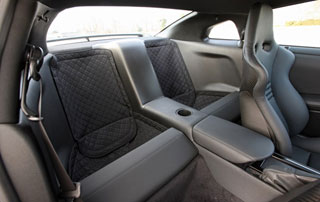
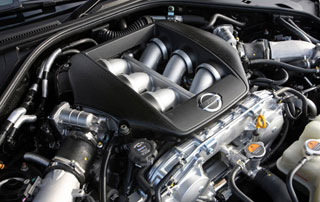
Source: Insideline

.jpg)
.jpg)
.jpg)
.jpg)
.jpg)
